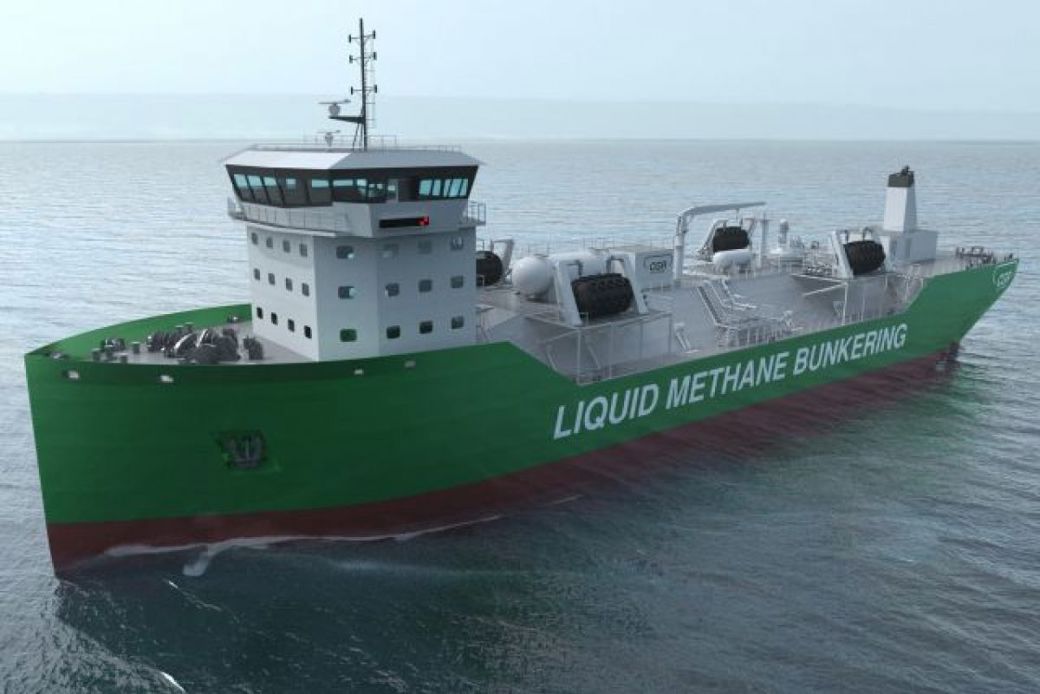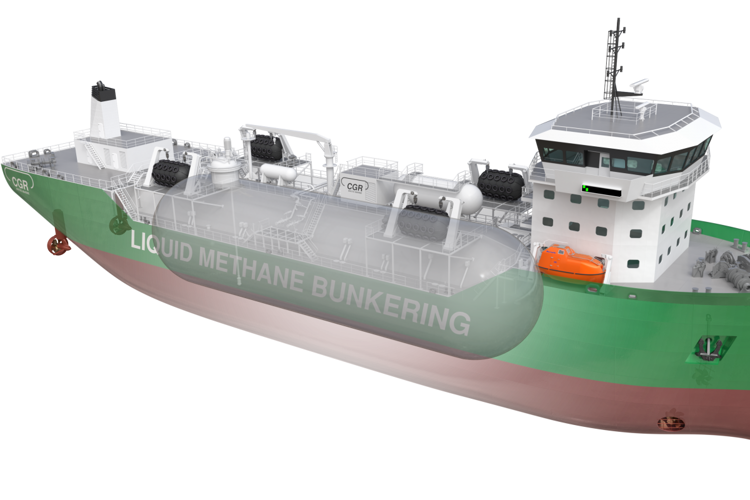
An above-par solution for LNG bunker vessel design
Bård Norberg of CGR Arctic Marine AS and Axel Andenæs of Kongsberg Maritime AS explain how the combined concepts behind the LMB6000 are being translated into a practical reality
Sometimes, combining the best available existing technologies has the effect of opening up an entirely new path. This has very much been the case with the cooperative processes leading to the development of the Norwegian technology provider CGR Arctic Marine’s 6,000m3 Liquid Methane Bunkering (LMB) vessel.
Designed by CGR in close consultation with the respected Chinese design institute SDARI, the LMB6000 will be fitted with a comprehensive, unified Kongsberg Maritime equipment solution comprising propulsion, remote control, gas engines, electrics, energy storage and integrated automation. The solution also includes KONGSBERG’s cargo tank instrumentation and FlexCTS Custody Transfer System, designed specifically for LNG Bunkering vessels.
Digitalisation also plays a key role. The vessel will use Kongsberg Maritime’s Information Management System (K-IMS), and can be connected to the cloud via KONGSBERG’s Global Secure Network. The K-IMS platform has been widely embraced by the LNG market and enables owners to make use of their data through a suite of tools and applications. The remote connection is used by KONGSBERG for Remote Services, a tool which has been of particularly high value during the pandemic.
The first two vessels, due for delivery in spring 2023, are about to be built by the Taizhou Wuzhou shipyard in China for Kanfer Shipping AS, a Norway-based developer of small and medium scale LNG transport and terminal solutions to whom CGR has handed the rights to commercially deploy these LNG bunkering and distribution vessels.
The project’s genesis can be traced back several years, as Bård Norberg, Director and founder of CGR Arctic Marine, recalls. “Everything began with ideas drawn on a napkin, which is where all innovation starts,” he laughs. “At the time, I was involved in an LNG project at Meyer’s Neptun Werft Shipyard in Rostock, Germany, and I started to think about how to use today’s technology in the design of a low-cost bunker vessel, itself running on LNG, that would be able to efficiently supply LNG fuel with the smallest possible environmental footprint, the minimum of complexity and the lowest possible capital (CAPEX) and operational (OPEX) expenditures.”
CAPEX optimization
Bård’s first consideration was the size of the cargo tank. Experience had proved to him that a 6,000m3 tank would provide sufficient capacity, capable of accommodating approximately 2,600 tonnes of LNG. The decision to opt for a mono-tank design was pursued as a means of keeping weight and costs down, improving hull utilisation and cutting down on the amount of cargo-handling equipment required on deck. “No compressors, no heat exchangers,” Bård smiles, “so CAPEX will be optimised in the building of these vessels.” There is also the potential to increase tank size by simply lengthening the hull: Bård already has 7,000m3 and 8,000m3 designs under consideration.
The LMB6000 is accordingly equipped with a single cargo tank, insulated with state-of-the-art spray foam thermal insulation technology. “This minimises the LNG boil-off rate,” Bård points out, “limiting it to no more than 0.12% per day.”
This high level of insulation ensures optimal efficiency for another key feature of the new vessel: its onboard cargo-handling plant, which uses the cryogenic gas recovery technology from which CGR derives its company acronym. Capable of combining cooling, reliquefication and gas recovery during loading, discharge and gas-freeing operations, the CGR process plant’s cryogenic condensation functionality uses heat exchange with liquid nitrogen to handle and recover cargo boil-off sustainably. This negates the need to dispose of it via incineration, flare or GCU (Gas Combustion Unit). Any vapour gases are instantly re-liquefied in the heat exchange process.
CGR process plants operate using proven cryogenic gas recovery technology which has been in existence for 20 years, but this will be the first time it has been designed for and installed on a vessel. “The plant will handle any type of boil-off very rapidly,” Bård confirms, “with a capacity of three to four tonnes an hour.”
A perfect match
The next ingredient which Bård factored into his planning was the choice of engine. “With LNG fuel, CO2 and NOX emissions are the lowest you can get,” he says, “so I naturally felt that these vessels should use pure gas engines for power production, coupled with hybrid technology.”
It was the need for a straightforward, integrated solution to support this conviction which brought Kongsberg Maritime into the picture. “I felt that KONGSBERG’s knowledge of electronic installations and our extensive experience with LNG carriers would make a perfect match,” Bård observes.
“We have been working very closely with CGR Arctic Marine since February last year to provide our input,” continues Axel Andenæs, Sales Manager, Global Sales and Marketing, Integrated Solutions (OPU and LNG), Kongsberg Maritime. “The ship design is focused on simplicity, going for pure gas instead of dual fuel, which means fewer systems and lower costs. We’ve thought very carefully about the best way of configuring our hybrid technology to facilitate peak shaving, optimising the vessel’s energy production and consumption to avoid the running of auxiliary engines any more than is necessary.
“Another aspect of this is that the vessel will be able to bunker alongside a cruise ship to discharge and unload on battery power only, without the use of generators, so there will be no exhaust fumes emanating from the vessel and an absolute minimum of noise and disturbance.”
Optimal efficiency
The vessels will accordingly be fitted with Bergen C26:33 gas engines with CPM (Cylinder Pressure Monitoring) to stabilise engine performance, reduce component stress and improve reliability. The plug-in hybrid power system, meanwhile, will consist of modular lithium-ion battery packs and a redundant pair of 1,550kW pure gas generators. The battery packs will allow the generators to run at optimal efficiency and consume less fuel during manoeuvring, slow-speed and latency operations.
“When the batteries are empty, we can just start the generators and charge them in three hours, and they’ll be fully charged again,” Bård comments. “If we go alongside a terminal with fully charged batteries, we won’t need to run generators for loading the vessel. We’ll have enough energy to cover the entire loading operation, only starting the generators when leaving port and going to the discharging field. This vessel is not only designed for bunkering, but also for short-sea distribution.”
As an additional safety measure, KONGSBERG’s liquid-cooled, small-footprint Energy Storage System (ESS) incorporates multiple safety barriers to prevent thermal runaway between modules.
Soft landings
Extreme manoeuvrability and accessibility were also of prime importance in the vessel design, expediting operations in narrow, constrained port waters alongside other craft. Kongsberg Maritime’s solution has been to install a bow thruster and a redundant pair of 360° Azipull thrusters which can be operated by means of an independent Poscon joystick system. The Azipull thrusters combine superior efficiency in transit with excellent manoeuvring capabilities.
“This makes operations more simple and far safer because we can execute soft landings to the shoreside and to other ships,” Bård says. “The risk of touching is basically avoided. Gas carriers going into ports or carrying out operations are normally assisted by tugboats, but our goal is to remove the need for these and limit port expenses by being able to operate safely and redundantly ourselves.”
Bård is in no doubt about the LMB6000’s potential in a sustainability-conscious marketplace where LNG is becoming an increasingly attractive proposition. “We basically want to be seen as a role model for the bunkering industry,” he states. “We’ve had many Teams meetings with major customers in the global oil and gas industry who have confirmed that our design will make a real difference.
“Somebody also described it as a game-changer: I don’t like to use such terms, but the proof is in the pudding. My own little slogan is ‘From black to green, simple and clean: pure gas’. The vessel makes sound business sense on both a commercial and environmental level. Even when factoring in the added expenditure on propulsion and batteries, we’ll still be able to offer this vessel at a far lower CAPEX and OPEX than the competition.”
For further information, please contact:
